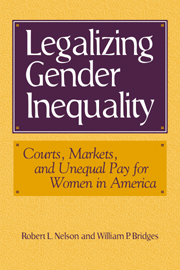Book contents
- Frontmatter
- Contents
- List of Figures and Tables
- Acknowledgments
- 1 Law, Markets, and the Institutional Construction of Gender Inequality in Pay
- Part I Theory and Method
- Part II The Case Studies
- 5 Paternalism and Politics in a University Pay System: Christensen v. State of Iowa
- 6 Bureaucratic Politics and Gender Inequality in a State Pay System: AFSCME v. State of Washington
- 7 Corporate Politics, Rationalization, and Managerial Discretion: EEOC v. Sears, Roebuck & Co.
- 8 The Financial Institution as a Male, Profit-Making Club: Glass v. Coastal Bank
- Part III Conclusion: Legalizing Gender Inequality
- Appendix: Court Documents and Case Materials Used in Case Studies
- References
- Index
7 - Corporate Politics, Rationalization, and Managerial Discretion: EEOC v. Sears, Roebuck & Co.
Published online by Cambridge University Press: 07 August 2009
- Frontmatter
- Contents
- List of Figures and Tables
- Acknowledgments
- 1 Law, Markets, and the Institutional Construction of Gender Inequality in Pay
- Part I Theory and Method
- Part II The Case Studies
- 5 Paternalism and Politics in a University Pay System: Christensen v. State of Iowa
- 6 Bureaucratic Politics and Gender Inequality in a State Pay System: AFSCME v. State of Washington
- 7 Corporate Politics, Rationalization, and Managerial Discretion: EEOC v. Sears, Roebuck & Co.
- 8 The Financial Institution as a Male, Profit-Making Club: Glass v. Coastal Bank
- Part III Conclusion: Legalizing Gender Inequality
- Appendix: Court Documents and Case Materials Used in Case Studies
- References
- Index
Summary
We now turn to patterns of gender inequality in pay in private sector organizations. The first case we consider is the massive litigation brought by the Equal Employment Opportunity Commission (EEOC) against Sears, Roebuck and Company, at that time the largest retailer of general merchandise in the United States.
Sears employed some 380,000 workers in over 4,000 facilities in 1986 (Sears I, p. 1288; for abbreviations, see the appendix on court documents and case materials). A sophisticated personnel department had been in existence for several decades that ran training programs, regularly collected attitudinal and performance data about employees, and administered batteries of psychological tests used for hiring and promotion decisions. Yet Sears had been built on an ideology of decentralized management. Group, territorial, and store managers had largely unchecked authority in many organizational functions. Among the most significant was discretion in setting the salaries of more than 18,000 middle-level managers and supervisors who reported to them – a group known as “checklist” employees.
In the 1970s the highly decentralized character of Sears's personnel and compensation policies came under internal and external attack. Although Sears had adopted an affirmative action program in 1968, in 1973 the EEOC filed administrative charges of sex discrimination against the company. Perhaps in response to the threat of government sanction, top management made the program mandatory in 1974. Company officials ordered that one out of every two lower-level (known as time-card) positions be filled by women or minorities.
- Type
- Chapter
- Information
- Legalizing Gender InequalityCourts, Markets and Unequal Pay for Women in America, pp. 203 - 243Publisher: Cambridge University PressPrint publication year: 1999



